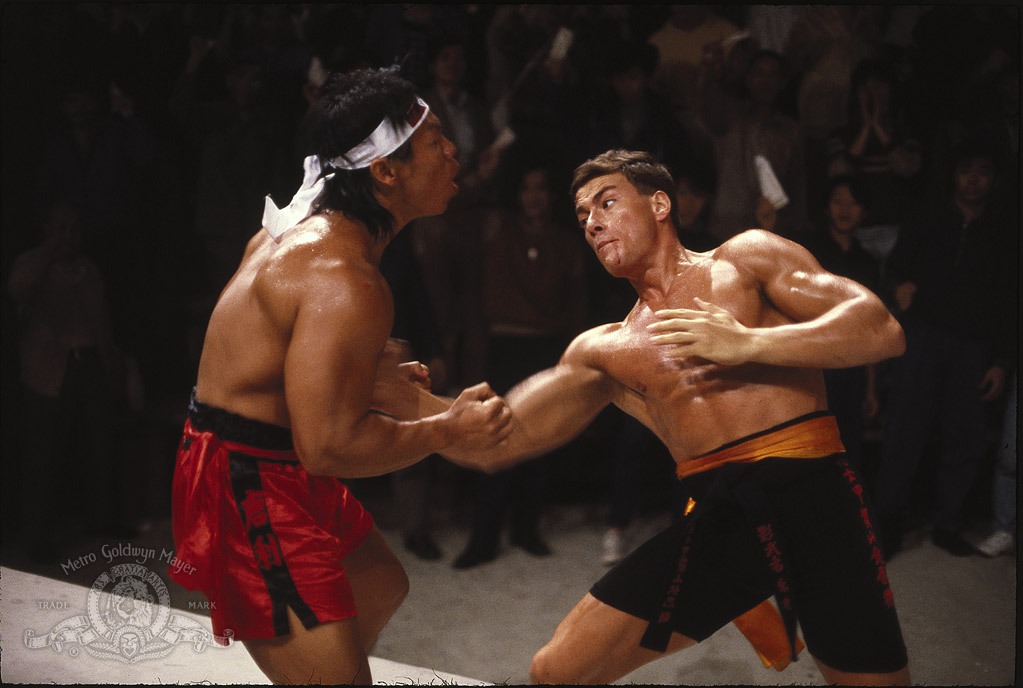Bloodsport (1988)

“Bloodsport” (1988), directed by Newt Arnold and produced by Cannon Group, is an iconic martial arts film that has left a lasting impact on the genre. Starring Jean-Claude Van Damme in his breakthrough role, the film blends action, drama, and a touch of sportsmanship into a compelling narrative centered around an underground fighting tournament. “Bloodsport” is celebrated for its intense fight sequences, charismatic performances, and its role in popularizing martial arts in Western cinema.
“Bloodsport” follows the story of Frank Dux, a young martial artist played by Jean-Claude Van Damme, who is determined to compete in the Kumite, an illegal and highly secretive martial arts tournament held in Hong Kong. The Kumite is known for its brutal and no-holds-barred approach, attracting fighters from around the world who come to showcase their skills and seek glory.
The film begins with a prologue that introduces Frank Dux’s background. Raised and trained in the martial arts by his adoptive father, Tanaka, Frank is prepared for the rigorous demands of the Kumite. His motivation for participating is personal: he aims to honor his mentor’s memory and prove his own abilities. Despite initial resistance from his commanding officers and family, Frank ultimately travels to Hong Kong to fulfill his goal.

The structure of “Bloodsport” is straightforward yet effective. It alternates between build-up, training montages, and intense fight sequences. The first act establishes Frank’s motivations and introduces key characters, including his friend and mentor Tanaka, played by the legendary martial artist Norman Burton, and his rival, Chong Li (Bolo Yeung), who is portrayed as a formidable and ruthless opponent.
The second act focuses on the lead-up to the Kumite, showcasing Frank’s training and preparation. The film’s training montages are emblematic of the 1980s martial arts genre, emphasizing physical conditioning and technique. The Kumite itself forms the film’s climax, with a series of increasingly dramatic and high-stakes fights leading to a final showdown between Frank and Chong Li.
Jean-Claude Van Damme’s portrayal of Frank Dux is central to the film’s success. Frank is depicted as a dedicated and honorable fighter with a personal code of ethics. His journey is not just about physical competition but also about personal growth and overcoming internal and external obstacles. Van Damme’s performance captures Frank’s determination, resilience, and skill, making him a relatable and charismatic hero.

Chong Li, played by Bolo Yeung, serves as the primary antagonist and adds a significant layer of tension to the film. His character is portrayed as a ruthless and dominant force in the Kumite, creating a formidable challenge for Frank. Chong Li’s menacing presence and fighting prowess contrast sharply with Frank’s principled approach, heightening the film’s dramatic stakes.
Supporting characters, such as the U.S. military officials who initially disapprove of Frank’s participation and his fellow fighters in the Kumite, add depth to the story. The camaraderie and rivalries among the fighters contribute to the film’s dynamic and engaging atmosphere.
“Bloodsport” explores themes of honor, perseverance, and the quest for personal validation. Frank Dux’s journey embodies the idea of fighting not just for victory but for a deeper sense of purpose and respect. The Kumite serves as a symbol of ultimate combat and personal challenge, representing the pinnacle of martial arts achievement and the test of one’s abilities and values.

The film also delves into the concept of honor in martial arts. Frank’s adherence to his principles and his respect for his opponents contrast with the more unscrupulous behavior of some of the other fighters, particularly Chong Li. This thematic contrast underscores the moral and ethical dimensions of the competition.
The visual style of “Bloodsport” is characterized by its energetic and intense fight choreography. The film’s fight scenes are choreographed with a focus on showcasing a variety of martial arts techniques, from traditional forms to more modern approaches. The cinematography captures the fluidity and brutality of the fights, using dynamic angles and close-ups to emphasize the action.
The film’s use of training montages, set against a synthesizer-heavy soundtrack, is a hallmark of 1980s action films. These sequences not only highlight Frank’s physical preparation but also build anticipation for the Kumite itself. The combination of practical effects, stunt work, and camera techniques contributes to the film’s thrilling and immersive action sequences.

“Bloodsport” has had a significant impact on the martial arts genre and popular culture. It played a key role in establishing Jean-Claude Van Damme as a major action star and helped to bring martial arts films into the mainstream. The film’s influence can be seen in subsequent action movies and martial arts competitions, as it popularized the concept of underground fighting tournaments and showcased a range of martial arts styles.
The film’s legacy is also marked by its memorable fight scenes, iconic performances, and its contribution to the genre’s evolution. “Bloodsport” remains a cult classic and is often cited as one of the definitive examples of 1980s action cinema. Its success paved the way for future martial arts films and established a template for action-oriented storytelling in the genre.
“Bloodsport” (1988) is a seminal martial arts film that combines thrilling action with a compelling narrative. Through its engaging plot, dynamic fight choreography, and memorable performances, particularly by Jean-Claude Van Damme, the film has left an enduring mark on the genre. Its exploration of honor, perseverance, and personal validation resonates with audiences, while its high-energy action sequences and iconic moments have cemented its status as a classic in martial arts cinema. “Bloodsport” continues to be celebrated for its contributions to the genre and its influence on the portrayal of martial arts in film.











